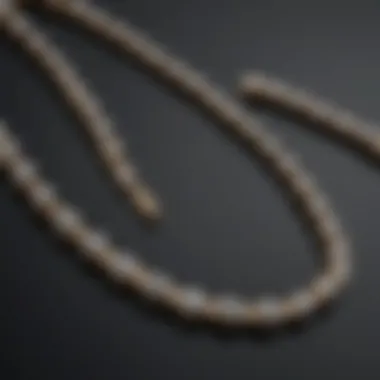Exploring the Intricacies of Diamond Studded Chains


Intro
The fascination with diamond studded chains stems from their beauty and intrinsic value. These exquisite pieces of jewelry hold a significant place in the hearts of enthusiasts and collectors alike. Their allure is not merely in the sparkling diamonds, but also in the craftsmanship and artistry that goes into creating them. This article aims to unveil the complexities associated with diamond studded chains, examining their history, craftsmanship, and market trends.
Gemstone Overview
Definition and Characteristics
Diamonds are a form of carbon, known for their unmatched hardness and brilliance. They are formed under intense pressure and temperature deep within the Earth, giving them a unique structure that reflects light in captivating ways. A well-cut diamond exhibits a characteristic sparkle and fire, which enhances its appeal when set in jewelry. The quality of diamonds is mainly assessed by the Four Cs: Carat, Cut, Color, and Clarity.
Classification of Gemstones
Gemstones can be classified into two broad categories: precious and semi-precious. Diamonds fall into the precious gemstone category alongside rubies, sapphires, and emeralds. This classification is based on rarity, beauty, and historical significance.
- Precious Gemstones: Diamonds, Rubies, Sapphires, Emeralds.
- Semi-Precious Gemstones: Amethyst, Topaz, Turquoise, Garnet.
Historical Significance
Ancient Uses and Cultural Importance
Historically, diamonds have held a revered status across many cultures. They were believed to possess protective qualities and were often used in royal regalia. Ancient Indians regarded diamonds as sacred, while in Europe, they became symbols of power and wealth during the Renaissance.
Myths and Legends Surrounding Gemstones
Diamonds are intertwined with numerous myths and legends. It was said that diamonds could ward off evil spirits and bring good luck to their wearers. Such beliefs have contributed to the enduring fascination with diamond studded chains, making them symbols of both protection and status.
Diamonds, with their inherent brilliance, are not just adornments; they are storied pieces of art that encapsulate history and culture, resonating with the wearer and the observer alike.
Prologue to Diamond Studded Chains
Diamond studded chains hold a unique place in the world of jewelry. These chains not only serve a decorative function but also reflect the wearer's status and taste. The combination of diamonds and chains produces an aesthetic that appeals to many. Beyond their visual allure, diamond studded chains can hold significant investment value. They embody craftsmanship and design sophistication while housing precious gemstones.
Understanding diamond studded chains requires an appreciation of both their beauty and the factors that influence their appeal. The quality of the diamonds, the craftsmanship behind the chains, and their evolving market trends all play vital roles in defining the chain's ultimate allure.
Considerations for potential buyers include the quality of the diamonds, which is determined by the Four Cs: cut, color, clarity, and carat weight. Each element contributes not just to the visual appeal but also to the long-term value of the piece. Furthermore, trends in craftsmanship and materials used can directly affect the desirability and price of diamond studded chains.
Consumers should also be aware of the various market dynamics. Fluctuations in demand can affect availability and pricing, similar to how fashion trends can lead to shifts in consumer preference.
In summary, exploring diamond studded chains is essential for anyone invested in the gemstone and jewelry market. The intersection of beauty, luxury, and investment potential makes these chains a significant topic of consideration. Understanding these elements enhances appreciation and informs better purchasing decisions.
A Brief History of Chain Jewelry
Understanding the history of chain jewelry is paramount in appreciating the artistry involved in its evolution. Chain designs have functioned as both adornment and symbol throughout history. They reflect trends, cultures, and even technological advancements in jewelry making.
As diamond studded chains have developed, they have embraced elements of aesthetics and craftsmanship that have defined various eras. This section aims to explore foundational moments and transformations in the development of chains, shedding light on why they hold a significant place in jewelry today.
Origins of Chain Design
The origins of chain design date back thousands of years. Early chains were often crafted from bronze or gold, fashioned into intricate links. Some of the earliest forms can be traced to ancient civilizations, where chains were utilized as part of ceremonial attire.
For instance, the ancient Egyptians incorporated chains into their jewelry, adorning themselves with precious metals and stones that signified their wealth and status. Interestingly, the simplicity of the initial designs paved the way for more complex styles that emerged over time.
Evolution through the Ages
Chain jewelry has witnessed significant evolutions through history. From the Romans, who favored large chains for their robust designs, to the delicate and refined styles of the Renaissance, each period introduced a unique approach to chains.
In addition, the Industrial Revolution introduced mass production techniques that allowed for the creation of standardized chain links, making jewelry more accessible to the general population. As a result, chains became increasingly integrated into everyday fashion.
"Chains are more than just connecting links; they signify continuity and tradition in the extensive narrative of jewelry design."
The modern era has seen the melding of traditional craftsmanship with innovative designs, allowing for the creation of diamond studded chains that can blend with various styles—from minimalistic to extravagant. Therefore, understanding the history of chains enriches the knowledge surrounding their significance and place in today’s jewelry market.
Understanding Diamond Quality
Understanding diamond quality is crucial for anyone interested in diamond studded chains. The quality of the diamonds impacts not only the aesthetic appeal but also the overall value of the piece. Buyers must consider various aspects before making a purchase. The Four Cs—Cut, Color, Clarity, and Carat Weight—are central to assessing a diamond's quality. Each of these elements contributes to the stone's beauty and rarity, making them significant in choosing quality diamond jewelry.
The Four Cs of Diamonds
Cut
The cut of a diamond refers to how well it has been shaped and faceted. This aspect significantly affects how light interacts with the stone, influencing its brilliance and sparkle. A well-cut diamond reflects light beautifully, enhancing its visual appeal. It is seen as one of the most important factors in diamond quality because it directly impacts the aesthetic. However, a poorly cut diamond will appear dull, regardless of its other characteristics. Therefore, buyers often prioritize cut to ensure they invest in a stunning piece of jewelry.


Color
The color of a diamond is assessed on a scale from D (colorless) to Z (light yellow or brown). Typically, the closer to colorless, the more valuable the diamond. Color can dramatically influence the overall appearance of the chain. Colorless diamonds allow more light to pass through, resulting in more brilliance and fire. Yet, fancy colored diamonds—like pink or blue—can also hold great value, depending on rarity. Understanding color is vital for discerning buyers who seek either classic or unique aesthetic qualities in their diamond studded chains.
Clarity
Clarity refers to the presence of inclusions or blemishes in a diamond. Higher clarity means fewer imperfections, making the stone more visually appealing and valuable. Diamonds are graded on a scale that ranges from Flawless to Included. A diamond with high clarity allows for better light performance, enhancing its sparkle. Collectors and enthusiasts often favor diamonds with fewer inclusions, as they signify purity and care in the stone's nature. Clarity plays a significant role in final decision-making when purchasing diamond jewelry.
Carat Weight
Carat weight measures the size of the diamond. Generally, larger diamonds are rarer and more valuable, which makes carat weight a significant consideration for buyers. However, it is important to note that carat weight alone does not determine quality. A smaller diamond with an excellent cut, color, and clarity can surpass a larger diamond of lesser quality. Buyers must balance size with other quality factors to ensure they are making an informed decision.
Grading Systems and Certifications
Certification systems are essential for verifying the quality of diamonds. Organizations like the Gemological Institute of America (GIA) and the American Gem Society (AGS) provide grading reports. These reports detail the Four Cs of the diamond, giving buyers confidence in their purchases. It's important to look for certified diamonds to avoid misrepresentation. A grading certification can serve as proof of the diamond’s quality, protecting buyers from potential fraud or errors in judgment.
Craftsmanship of Diamond Studded Chains
The craftsmanship of diamond studded chains is pivotal in creating pieces that are both aesthetic and functional. Each chain is the result of meticulous work, showcasing a blend of traditional techniques and modern innovation. Understanding this craftsmanship helps appreciate the value of these chains, both in terms of beauty and investment.
Design Techniques
Design plays a crucial role in the overall appeal of diamond studded chains. Designers use various techniques to ensure that these pieces not only attract attention but also stand the test of time. The careful planning of the artwork is essential, whether it is minimalist or has elaborate designs.
- Sketching and Modeling: It begins with sketches, where ideas evolve into more concrete blueprints. Designers often create scale models, often using CAD software, to visualize the final product.
- Incorporating Balance: Balancing the weight and proportions of diamonds with the chain itself ensures comfort and style. Equal attention is given to the diamond placement to maintain an even distribution across the chain.
- Collaboration with Jewelers: Designers frequently work closely with skilled jewelers to merge creativity with craftsmanship. This relationship enhances the quality of the final piece, as practical challenges are met with expert solutions.
Materials Used in Creation
The creation of diamond studded chains involves a selection of high-quality materials, which significantly influence the final product.
Types of Metals
Metal choice is foundational in the craftsmanship of diamond studded chains. Commonly used metals include gold, silver, and platinum. Each possesses unique characteristics contributing to the overall quality.
- Gold: Widely popular due to its malleability and luster. Gold can be alloyed with other metals to enhance its strength and color. Yellow, white, and rose gold are all variations that appeal to different tastes. However, gold can scratch easily.
- Silver: Known for its affordability and shine, silver can tarnish over time. Its softer nature makes it less durable for everyday wear compared to gold or platinum.
- Platinum: This metal is favored for its strength and hypoallergenic properties. It maintains its sheen over time and does not tarnish, making it an excellent choice for luxury jewelry. However, the high cost may limit its accessibility.
These metal options provide collectors and enthusiasts with various choices for their chains, depending on aesthetics and budget.
Finishings and Platings
Finishings and platings impact how diamond studded chains look and wear. This aspect should not be overlooked when considering craftsmanship.
- Rhodium Plating: Commonly used on white gold, rhodium creates a shiny, reflective finish. Its protective properties help enhance the jewelry's durability while preventing tarnishing. Nevertheless, it may require reapplication over time to maintain its appearance.
- Polished and Matte Finishes: Different finishes offer varying visual effects. A matte finish brings a contemporary edge, while a polished finish exudes glamour. Each serves a distinct purpose, influencing how light interacts with the chain.
- Antique Finish: This option provides an aged look that appeals to vintage collectors. It may highlight the intricate details of the craftsmanship, though it can obscure the shine of the metal.
In summary, the craftsmanship of diamond studded chains is multifaceted. The integration of careful design techniques and a selection of high-quality materials results in pieces that stand out for their beauty and durability. Understanding these elements can enhance the appreciation of any chain's exquisite artistry.
"Craftsmanship in jewelry is where creativity meets precision, resulting in timeless pieces that can be cherished for generations."
Market Trends in Diamond Jewelry
Understanding the market trends in diamond jewelry is essential for anyone involved in the industry. The demand for diamond studded chains can offer insights into consumer preferences, investment opportunities, and the overall trajectory of the jewelry market. This section will discuss the various factors influencing current trends, including consumer demand, investment considerations, and the impact of fashion.
Current Demand for Diamond Studded Chains
The current demand for diamond studded chains reflects a growing appreciation for luxury jewelry. Consumers are not only looking for aesthetic appeal but also for pieces that signify status and wealth. This demand is driven by several factors:
- Social Media Influence: Platforms like Instagram and Pinterest play a significant role in shaping consumer preferences. Influencers and celebrities often showcase their diamond jewelry, making it desirable among the public.
- Celebrate Life Events: Many individuals choose diamond jewelry for significant life milestones such as anniversaries, graduations, and other celebratory occasions. This has made diamond studded chains a popular gift choice.
- Longevity and Investment: Buyers increasingly view diamond jewelry as a long-term investment. Therefore, they seek out chains that not only look good but also hold their value over time.
This growing demand opens up various avenues for jewelers and retailers alike to cater to a diverse customer base.
Investment Considerations
When it comes to investing in diamond studded chains, several aspects require careful consideration. First, potential buyers should be aware of the market fluctuations that can affect diamond prices. Several points include:
- Quality Assessment: It is crucial to understand the diamond quality, focusing on the Four Cs: Cut, Color, Clarity, and Carat weight. High-quality diamonds will usually appreciate more reliably over time.
- Market Research: Staying informed on the latest trends and sales data will allow investors to make educated choices. Reports from sources like the Rapaport and industry experts are beneficial for tracking diamond prices.
- Emerging Markets: Interest in diamond jewelry is rising in countries like India and China. Engaging with these markets may provide unique investment opportunities.


Investors should evaluate their portfolio goals and align their diamond purchases accordingly.
Impact of Fashion Trends
Fashion trends considerably influence the popularity of diamond studded chains. Designers work hard to predict and respond to these trends to appeal to consumers. Here are several elements at play:
- Celebrity Endorsements: As high-profile personalities showcase diamond chains in public, their followers often emulate these styles, driving demand.
- Style Evolution: Trends like minimalist designs versus elaborate styles impact consumer choices. Current fashions may prefer simpler chains adorned with fewer but larger diamonds.
- Occasions and Cultural Shifts: The importance of holidays and significant events translates into product marketing strategies, prompting retailers to align their offerings accordingly.
The interlinking of fashion and luxury creates a dynamic marketplace where both trends and consumer behavior significantly influence demand.
Conclusion: Understanding market trends in diamond jewelry is critical for both consumers and investors. Staying abreast of current demands, investment considerations, and fashion influences will lead to informed decisions in this evolving industry.
Caring for Your Diamond Studded Chain
Caring for your diamond studded chain is crucial for maintaining its luster and integrity over time. These pieces of jewelry often carry significant emotional and financial value. Proper maintenance enhances this value and ensures that the chain remains a stunning accessory. Neglecting care can lead to damage, such as scratched surfaces or loose diamonds. Thus, understanding how to properly clean and store your diamond studded chain is essential for every owner.
Proper Cleaning Techniques
Cleaning diamond studded chains requires attention to detail and the right tools. For most chains, gentle cleaning can restore their shine without causing any damage. You can follow these basic steps:
- Prepare a Cleaning Solution: Use lukewarm water mixed with a few drops of mild dish soap.
- Soak the Chain: Let the chain soak for about 15-20 minutes. This will loosen any dirt or oil that may have accumulated.
- Gently Scrub: Using a soft toothbrush, scrub the chain gently. Focus on the diamond settings to ensure no dirt gets trapped.
- Rinse Thoroughly: Rinse the chain under running water to remove any soap residue. Ensure the plug is in the sink to prevent accidents.
- Dry with Care: Use a soft, lint-free cloth to dry the chain. Avoid paper towels as they can scratch the metal or diamonds.
In addition to regular cleaning, consider having your jewelry professionally cleaned at least once a year. Professionals can detect and address any concerns about the chain, such as loose stones.
Storage Recommendations
Proper storage of your diamond studded chain is just as important as cleaning. Storing it incorrectly can lead to tangling or scratching against other jewelry. Here are some practical storage tips:
- Use a Lined Jewelry Box: Store your chain in a soft-lined box or pouch to avoid scratches from other pieces of jewelry.
- Keep it Separate: Avoid storing multiple chains in one pouch or compartment. This minimizes the risk of tangling or damage.
- Avoid Humidity: Store the chain in a dry environment. Excess moisture can lead to tarnishing of the metal and affect the diamonds.
- Consider a Safe: For high-value chains, a safe may be the best option for secure storage.
Regular maintenance enhances the appearance and longevity of your diamond studded chain.
Following these cleaning techniques and storage recommendations will ensure that your diamond studded chain remains in top condition for years to come. Attention to detail in the care process reflects the overall appreciation of the craftsmanship and the emotional value this jewelry holds.
Purchasing a Diamond Studded Chain
Buying a diamond studded chain involves significant consideration, as it is more than a mere transaction. This purchase represents an investment in beauty, craftsmanship, and sometimes, prestige. The complexity of the market means that informed decisions lead to satisfaction and value retention over time. Understanding the details of what makes a quality chain and the purchasing process can enhance one’s experience.
Evaluating Retail Options
When it comes to evaluating retail options for diamond studded chains, many factors should guide your choice. The growing variety of retail platforms—from online marketplaces to local jewelers—offers both advantages and challenges. Here's what to consider:
- Reputation of the Retailer: Always start by checking customer reviews and ratings. A reputable retailer is more likely to provide quality products and customer service.
- Selection: Evaluate the range of designs and styles available. A wide selection indicates a higher likelihood of finding something that resonates with your taste.
- Pricing Transparency: Understanding how prices are structured is crucial. Some retailers may inflate prices with heavy markups, whereas others offer competitive, fair pricing.
- Return Policies: A robust return policy can protect buyers from unsatisfactory purchases. Be sure to read and understand the terms.
- Customer Support: Prompt and helpful customer support can be a significant predictor of a positive purchasing experience.
Authentication Process
Authentication is fundamental in the purchase of diamond studded chains. The diamond market can be a minefield of misrepresentation and fraud. Therefore, understanding how to validate a diamond's quality and authenticity is essential.
- Certification: Look for diamonds with certifications from recognized grading organizations, such as GIA or AGS. A certification provides a benchmark for the diamond’s cut, color, clarity, and carat weight.
- Documentation: Ask for paper trails and documents that verify the origins of both diamonds and metals. These can often reveal the chain’s history and handling.
- Expert Appraisal: If in doubt, consider getting the chain appraised by a qualified gemologist. An unbiased assessment will help validate your purchase.
- Vendor Reputation: Always be cautious if the vendor is reluctant to provide details about authenticity or certifications. A trustworthy vendor should be open and forthcoming about these aspects.
Understanding these components in the purchasing process will not only aid in making an informed decision but also ensure that your investment in a diamond studded chain remains sound and valuable for years to come.
Cultural Significance of Diamond Jewelry
Understanding the cultural significance of diamond jewelry is crucial in exploring its multifaceted presence in society. Diamonds have long transcended their physical attributes, emerging as symbols of wealth, power, and emotional sentiments across various cultures. The allure of diamond studded chains particularly reflects not just aesthetic appeal but also deeper values related to status and connection.
Diamonds often represent eternal commitment and luxurious lifestyle, making them pivotal in ceremonial and everyday contexts. When people think about diamonds, notions of love, fidelity, and prestige often come to mind. In many regions, gifting diamond jewelry marks special occasions such as engagements, weddings, and anniversaries, representing significant milestones and deep connections.
Symbolism in Various Cultures
Across different cultures, diamonds possess rich symbolic meanings. In Western contexts, diamonds are primarily viewed as a symbol of love and commitment, especially in engagement rings. This perception fuels a thriving market for diamond studded chains, often seen as extensions of this symbolism, displayed in celebrations or given as tokens of affection.
In ancient times, diamonds were believed to possess protective properties. Indian culture, for instance, regarded diamonds as tools for warding off evil. Similarly, in some African communities, diamonds are associated with tribal heritage and rituals, emphasizing their importance beyond mere adornment.


- Symbolic meanings can vary, including:
- Love and romance
- Protection and strength
- Wealth and power
These elements highlight the enduring nature of diamonds across generations and their ability to adapt to different cultural lenses.
Historical Use in Royalty
Historically, diamonds have adorned royal families, establishing their association with authority and sovereignty. Through the ages, monarchs have utilized diamond studded chains as symbols of their status, projecting power and grandeur. The famous Cullinan Diamond, a substantial gem unearthed in South Africa, was cut into various pieces, some of which are now set in the British Crown Jewels, reinforcing the diamond's association with regal status.
Royalty often used diamonds not only as decoration but also as symbols of the divine, believed to bestow divine favor on the wearer.
- Noteworthy facts include:
- The Star of Africa, part of the British crown jewels, emphasizes this historical connection.
- Many crowns and scepters feature diamonds prominently, reflecting their importance in coronation ceremonies.
Through their historical use in royalty, diamonds continue to symbolize authority and status. This cultural significance infuses diamond studded chains with a weight of tradition and legacy, making them more than mere decorative items.
"Diamonds carry messages of history, commitment, and legacy within their sparkling facets, bridging diverse cultures in a shared appreciation of this magnificent gem."
As we consider diamond jewelry's deep-rooted symbols and historical context, it becomes evident that diamond studded chains hold a narrative that transcends generations, weaving threads of cultural significance into their very essence.
Famous Diamond Studded Chains
Famous diamond studded chains represent the pinnacle of luxury and artistry in jewelry. Their significance in both aesthetic appeal and cultural symbolism cannot be overstated. These chains often serve as status symbols, cherished heirlooms, or even investments that appreciate over time. Understanding the renowned designers and historic pieces makes a connection between the chain's form and its rich legacy.
Notable Jewelry Designers
Throughout history, several jewelry designers have made a remarkable impact in the realm of diamond studded chains. Their creativity and expertise shaped the market and set trends. Notable names include:
- Harry Winston: Known as the "King of Diamonds", his creations boast unmatched elegance and intricacy.
- Cartier: This house is recognized for its timeless designs that pair diamonds with innovative metalwork.
- Bvlgari: Infamous for bold styles, Bvlgari intertwines colorful gemstones with diamonds, crafting extraordinary chains.
These designers not only elevate the chains they create, but they also play a significant role in the diamond jewelry market, influencing consumer tastes and elevating standards of craftsmanship.
Iconic Pieces in History
Certain diamond studded chains have gained legendary status. Among them:
- The Cartier Diamond Necklace worn by Grace Kelly: A stunning piece adorned with an intricate arrangement, celebrated for both its beauty and royal connection.
- The Nizam of Hyderabad's Diamond Necklace: This chain is a symbol of opulence and showcases a collection of rare diamonds dating back to the 19th century.
- The Marie Antoinette necklace: A piece that represents lavish excess, it remains a testament to the stylistic choices of the period.
Each of these iconic pieces transcends mere adornment. They embody history, art, and the fervent desire for beauty, reminding us of diamonds' enchanting allure.
"Famous diamond studded chains are more than accessories; they are chronicles of artistry and culture woven into every exquisite detail."
Understanding these chains helps collectors and enthusiasts appreciate their multifaceted nature and influences within the jewelry industry.
Future Trends in Diamond Studded Design
The diamond studded design landscape is evolving and becoming increasingly attuned to modern values and innovations. This section will delve into two important facets shaping the future of diamond jewelry: sustainability in gemstone sourcing and innovative techniques and materials in design. Understanding these trends is crucial for stakeholders, including collectors, enthusiasts, and jewelers, as they influence the choices of consumers and the industry's direction.
Sustainability in Gemstone Sourcing
Sustainability is no longer just a trend; it has become a necessity. Consumers are more informed and concerned about the origins of the gems they purchase. Sourcing practices must address ethical concerns and environmental impacts. The diamond industry has seen a shift towards ethically sourced diamonds, such as lab-grown diamonds or those obtained through responsible mining practices.
Benefits of sustainable sourcing include:
- Transparency: Buyers prefer knowing the complete journey of their diamonds, from source to sale.
- Environmental Responsibility: Sustainable practices reduce the ecological footprint.
- Consumer Trust: Brands committed to ethical sourcing gain credibility with socially-conscious consumers.
Some companies are adopting certification processes to verify the ethical origins of gems. For instance, the Kimberley Process aims to prevent the trade of conflict diamonds. These practices allow consumers to make informed choices and ensure that their purchases support ethical standards in the industry.
"Today's jewelry buyers are looking beyond the products. They want to align their purchases with their values and ethics."
Innovative Techniques and Materials
Innovation in design and production is another key trend for diamond studded chains. Advances in technology, especially in the field of manufacturing, have opened new avenues for creativity and efficiency. Some innovations include:
- 3D Printing: This technology allows for intricate designs that were previously difficult or impossible to achieve.
- New Composite Materials: Innovations like enhanced alloys offer strength and durability without sacrificing appearance.
- Advanced Laser Cutting: Precise cutting techniques can improve the quality and clarity of diamonds while reducing material waste.
In addition, the integration of wearable technology into jewelry is gaining momentum. Smart jewelry, with functionalities beyond decoration, is appealing to a tech-savvy audience. The fusion of luxury with technology will redefine what jewelry means, blending traditional aesthetics with modern functionalities.
As these trends evolve, they promise to reshape the consumer's experience in the diamond jewelry market, emphasizing values such as ethics and innovation.







